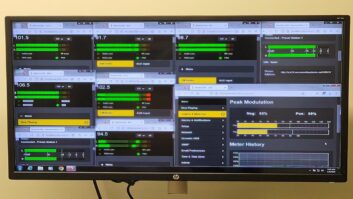Now that service from the AMC-18 satellite is running, we engineers need to swing untold thousands of dishes off the dying “bird” over the central Pacific. As you plan for this, veteran projects and contract engineer Mike McCarthy offers readers a few things to consider.
First, do you have a clear boresight path to the new bird? And if not, what is needed to achieve this?

Fig. 1: Check the integrity of the mesh dish.
Then inspect your dish to verify you can mechanically move the dish. It may be impossible to re-aim the dish if the hardware is so corroded that there is a risk of breaking fasteners holding the dish in place.
For mesh dishes, as shown in Fig. 1, ensure the parabola is structurally sound, not bent or damaged. If you have a mechanical issue, what do you do? You may be required to replace the dish, and for this, you need time!
Another consideration is determining the best time to do this re-aim. The answer, Mike writes, boils down to local conditions. For Mike’s clients, he will perform the re-aim after the risk of snow storms has passed, permitting him to work wearing a windbreaker. However, you should verify the new alignment, look angle and boresight path clearance as soon as possible, in the event a more significant solution is required.
As for the actual realignment, Mike suggests you first set up on your workbench a surplus StarGuide III that is set to one of the remaining networks still using the platform. Before you begin, make sure the receiver works on the network test channel — just to be sure you’re not dealing with a dead receiver or audio card. Next, wire in audio pairs for monitoring/testing using a battery powered amplifier and a pair of headphones set to the network’s test channel to verify operation.

Fig. 2: A weatherproofed service splice permits connecting the receiver at the dish.
Once you’re done testing the receiver on the bench, shut down the DC to the LNB and bring the receiver out to the dish, along with some AC power, a coax jumper, RF attenuator(s) and headphones. Open the service splice (Fig. 2) — you do have a service and arrestor/ground splice, right? Then connect the receiver to the dish, making sure to reapply LNB power.
Presuming you have confirmed a clear boresight path, happily aim away (don’t forget to adjust the polarization offset) until the best combination of Eb/No and AGC are realized on the receiver — adding attenuation as needed to verify fade margin headroom. As you do this, listen to your “confidence” audio on the new frequency, using the amplifier and headphones.

Fig. 3: After alignment, mark mounting nuts with a permanent marker.

Fig. 4: Also check black tie-wraps securing the cable to the LNB.
Once that’s done, lube and secure the hardware, secure the dish, reconnect the coax back into the studio, restore the LNB DC and check the receiver general operation, Eb/No, AGC and RF levels. As shown in Fig. 3, mark the mounting nut location with a permanent marker. Add or remove previously installed attenuation to make sure you’re in the sweet spot for each receiver. Once that is all done, then re-weather seal the coax service splice, and secure the cable using black tie-wraps, shown in Fig. 4.
Mike adds that if you don’t have a spare StarGuide III, try eBay; that’s where he got his.
In closing, Mike mentions www.dishpointer.com. They have a very accurate satellite overlay for checking azimuths. This is the first place Mike went to after seeing the change in birds. The site allows you to check look angle and bore sight.
Fortunately, all of Mike’s sites are clear, except for one contract station. It will take a transit to check the boresight for that station, and there is a significant chance that they might need to replace the dish.
Mike included this definition, as it relates to parabolic dishes: Boresight is a virtual cylinder of approximately the same diameter as the parabolic dish extended and centered along the dish’s axis of symmetry and maximum gain.
June 30, 2017, is the final date for affiliates to have their satellite downlinks repointed to 105 west. For general information about the U.S. radio industry’s migration of satellite service to AMC-18, see www.amc8migration.com/.
The clock is now ticking.
Contribute to Workbench. You’ll help your fellow engineers and qualify for SBE recertification credit. Send Workbench tips to [email protected]. Fax to (603) 472-4944.
Author John Bisset has spent 48 years in the broadcasting industry and is still learning. He handles West Coast sales for the Telos Alliance. John is SBE-certified and is a past recipient of the SBE’s Educator of the Year Award.












